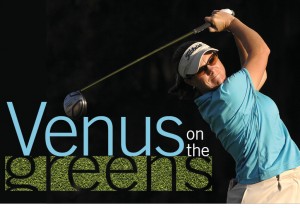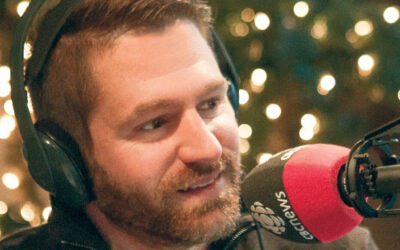
When celebrated LPGA golfer AJ Eathorne joins the pro staff at Predator Ridge in Vernon this season, she’ll also be joining the handful of women golf professionals and professional golf teachers who make their living in the Okanagan.
Meet four of these accomplished women. Find out what they bring to the sport, to their students (both female and male) and to the growing community of women golfers. And see how the tips they share can boost your game.
AJ Eathorne
News that AJ Eathorne was joining the pro staff at Predator Ridge made headlines across the professional golf world. Not only has she played for 11 years on the LPGA tour, she’s caddied for three years in both the LPGA and the PGA.
AJ isn’t a new face in the Okanagan Valley. She was born and raised in Penticton, and that’s where she was introduced to the game. She’s looking forward to living in the Valley again and especially to sharing what she’s learned over the years.
“Being around golf for so long, I’ve taken lessons every few weeks and had coaches, and on the tour I was like a sponge. I always wanted to hear what people were working on. Now I can be the person that relays all that information,” she says. “In the last few years the teaching I’ve done is mostly in clinic and group settings. It’s a lot of fun. You get a lot of feedback with groups. It’s nice to be around people who are excited to learn.”
What about Mars and Venus on the greens? AJ doesn’t believe men and women necessarily learn differently, but there are differences that can’t be ignored. “We’re just made up differently as far as our body composition goes, so our strengths and weaknesses are going to be different. Basically women have hip and lower body issues to work with. Men are stronger physically—their upper body and forearms are a lot stronger. Men are going to hit the ball farther than women.”
Ironically, AJ says men who play at a competitive recreational level have a lot to learn from women pros. “The average male amateur is just about equal to a female pro as far as distance and arm strength,” she says. “The tempo is really what you notice from women’s professional golf. It sets you apart from the average golfer. Tempo is key to their success and it’s a great thing others can learn from us.”
For someone trying to shave shots off their game, she advises, “Most of your scores are probably around the putting green. Let’s work on putting and chipping for now and you’ll see a difference; then we’ll work on length.”
And for those lucky golfers who get to take a camp or a lesson with AJ… “I think being able to tell a few stories here and there makes it a good and unique experience. I can tell what happened on the PGA tour or the LPGA tour, and the ins and outs of being on the road and what it’s like behind the scenes compared with what you see on TV.”
When Predator Ridge is covered in a blanket of snow, AJ plans to keep building her teaching practice in Phoenix, Arizona. “I can grab some clients down there and hopefully influence them to come visit me at Predator. It’s a win-win situation.” (www.predatorridge.com)
Tara Roden
Tara Roden’s love of golf is infectious. She was exposed to the game as a young girl, doing cartwheels down the fairways while her parents and older brothers played the course. Eventually she settled on her feet, picked up the clubs and hasn’t looked back.
By the time she was 16 she knew she wanted to teach golf. She’s been at it for 22 years and still brings her springboard energy to every aspect of the game—private lessons, coaching talented juniors, golf boot camps, competitive tournaments and simply talking about the sport.
About half of her students are women and over the years she’s concluded, “Teaching is done very well all over the world for men, but I don’t believe the women have been looked after the way they could be.” In her experience, men and women approach learning and improving their golf game very differently. With men, “They tend to come to me with what they’re doing wrong already identified. They’ve been studying and they’ve read the books and they know what it is,” she says. “My job is identifying what the issue really is and explaining it to them through drills.”
That almost never happens with her female students. “The majority of women that I teach say, ‘I don’t know—tell me.’ So, I’m educating women and deciphering for men.”
Their approach to playing is usually different too. “The majority of guys are a little more focused on their shot and on the game and their scores, and they look at their performance and then compare themselves with the other players. They compete—I love doing that myself,” says Tara.
“Women are very much the social side of life—nurturing and caring. But I always laugh when women say, ‘Oh, I’m not competitive.’ They are.” One of Tara’s passions is preparing women for tournament golf with the Let’s Play Great Golf competitive women’s league for the Okanagan.
For the purely recreational player, Tara says women need to understand that they’re entitled to take the time they need for each shot, but between shots, a little concentration goes a long way. “If you’re talking (which I do all the time) and you’re 30 yards from your ball, start looking at where you need it to go and by the time you get there, you’ve already made your decision what club you need. When you miss-hit a shot, get over it and go on to the next one and try it again.”
Most of Tara’s teaching takes place at Gallagher’s Canyon Golf and Country Club in Kelowna. In 2011 she was shortlisted for the Professional Golfers’ Association of British Columbia Teacher of the Year Award. Over the next several months, Tara is taking her love of golf for women to the marketplace with a new enterprise, “Empowering women to be whatever they want to be in the golf industry, from player to businesswoman.” (tararoden.com; www.gallagherscanyon.com)
Jo-Anne Grove
Jo-Anne Grove is an institution at the Kelowna Golf and Country Club (KGCC). Now in her 18th year as a CPGA (Canadian Professional Golfers Association) Class-A professional, she provides a range of services including teaching, pro shop duties, club fitting and tournament organization.
She came relatively late, and somewhat reluctantly, to the game of golf. “I thought it was a stupid game,” says Jo-Anne. “I played hockey competitively and team sports were my thing. But both my parents played golf and in 1987 I started going out with them for the odd casual game.” You know where this goes—she caught the golf bug, found out she had the juice to excel and made it her career.
Jo-Anne finds that 80 per cent of her students are women. “There’s no doubt that I’m better able (than a man) to understand the structure as well as other unique entities (i.e. hormones) that make up a woman golfer. I also know that a lot of women, especially beginners, are more comfortable and feel less intimidated with a woman pro,” she says.
“I have a very biomechanical approach to golf. I think it is imperative to take the mystery out of the golf swing.” She adds, “I like to engage the students by challenging them to help solve the puzzle called the golf swing. Communication and dialogue are key. I am very passionate about the role that my students take in their lessons. It is more about me being the guide to helping the students teach themselves.”
Jo-Anne recalls one client who only came for instruction because her husband bought her a lesson package. The woman actually hated golf. “We worked together and I discovered that she thought you could only play golf if you had played other sports during your life. Once we started discussing her ability to move her body in a fluid motion, she loosened up and got a bit more open minded. As we progressed and she started to get the ball airborne, she got hooked. She now plays more golf than her husband.”
While the number of women who play the game increases, Jo-Anne appreciates that the percentage of
women professionals is low. “Most golf professionals in Canada start out as junior golfers, and since there are far fewer junior girls, we see far fewer female pros,” she says. “Juniors who become good at golf usually go to school in the States where there is more opportunity for scholarships. If they can’t play professionally, they’re likely to enter a career based on their degree.” Jo-Anne concludes, “In Canada, golf is mainly a seasonal sport (except in the Lower Mainland), so short seasons may also play a part. During the season, the long hours make it hard to raise a family.” (www.kelownagolfandcountryclub.com)
Lynne Kildaw
Lynne Kildaw ranks among the World Golf Teachers Federation top 60 teachers worldwide. As a dual sport athlete (volleyball and basketball) at Grand Prairie Regional College, where she began her studies towards degrees in education, mathematics and nutrition, she knows all about athletic performance.
Even though her first experience of golf was at the ripe old age of 24, Lynne picked up the sport in the most natural way. She was working at a golf course and during breaks she began hitting balls on the driving range. She asked the golf pro (who happened to be Norm Boden who taught LPGA player and fellow Canadian Dawn Coe Jones) if she should take lessons. Norm watched her for a bit, and told her to just keep swinging and find out what worked for her. She did, and later that summer in her first round ever, Lynne shot a 92.
Trimming that score down to the low seventies was where she really discovered performance on the course was more about the brain than the skills. “People might have the best-on-the-range type of practice swing, but when they get to the course, it breaks down—for some it really, really breaks down,” she says. For men in particular, “They like it to be mechanical and break it down step-by-step-by-step: your address position; what your position should be at the top of your backswing; your club; your thumb… That’s what breaks down on the golf course.”
“I don’t teach like that,” says Lynne. “I really try to relate it to some other action they might do, even like lobbing a ball. I ask them to do certain things and I see perfect golf coordination with how the hips are moving, how the arms are moving, and everything is timed up and beautiful. Then they put that stupid stick in their hands and it goes away.”
“I’m saying, ‘I don’t have to teach your body how to move appropriately. I’ve got to find out why you’re in your way!” Lynne laughs, “I joke with people, ‘You keep reading those golf magazines and keep phoning me when you haven’t figured it out.’”
That’s one reason she likes to teach at courses like Skaha Meadows in Penticton. “If I can teach the way I like to, we start on the putting green, then the range and then take it on to the course. Par-3s and -4s are best for that.”
About 80 per cent of Lynne’s students are women. “Some ladies are more comfortable with a lady teaching them. As a woman I can talk about body parts and get right down to brass tacks. If you have to talk about your hips or breasts, I have a little more freedom and comfort to talk about what to do with them.”
Lynne’s goal is to give all of her students a lifelong love of the game. “The number one thing I ask all my golfers is ‘What’s your goal?’ Their goal might simply be that they want to go and enjoy a Sunday with their kids or grandkids on the golf course. This is a lifetime sport—you can be hooked up to an oxygen machine and not even get off the cart. Physical limitations are no barrier. Those with wheelchairs, fused vertebrae, missing limbs, hip and knee replacements, and very minimal range of motion can all enjoy golf.” She adds, “To make it last a lifetime you’re going to have your ups and downs as far as the mental part of the game goes. But if you can understand that in more detail, you’re more bound to stick with it and to go out and literally enjoy nature—the beauty of the course, the smells, everything about it.”
One of Lynne’s tips for all golfers, but particularly those new to the game is this: rank your shots on the sweetness scale. “Everybody should know what a sweet ball feels like. It has a different feeling, different sound and it seems to go farther. It feels like you’ve done nothing.” She says this helps golfers to focus on the positive, “When you hit a sweet one, make a happy face on your scorecard.”
In the off-season, Lynne puts her master herbalist skills to work in a wellness business she shares with partner Ean Langille. (www.skahameadowsgolf.com; www.totalwellness.ca) ~ Barbara Sutherland



0 Comments